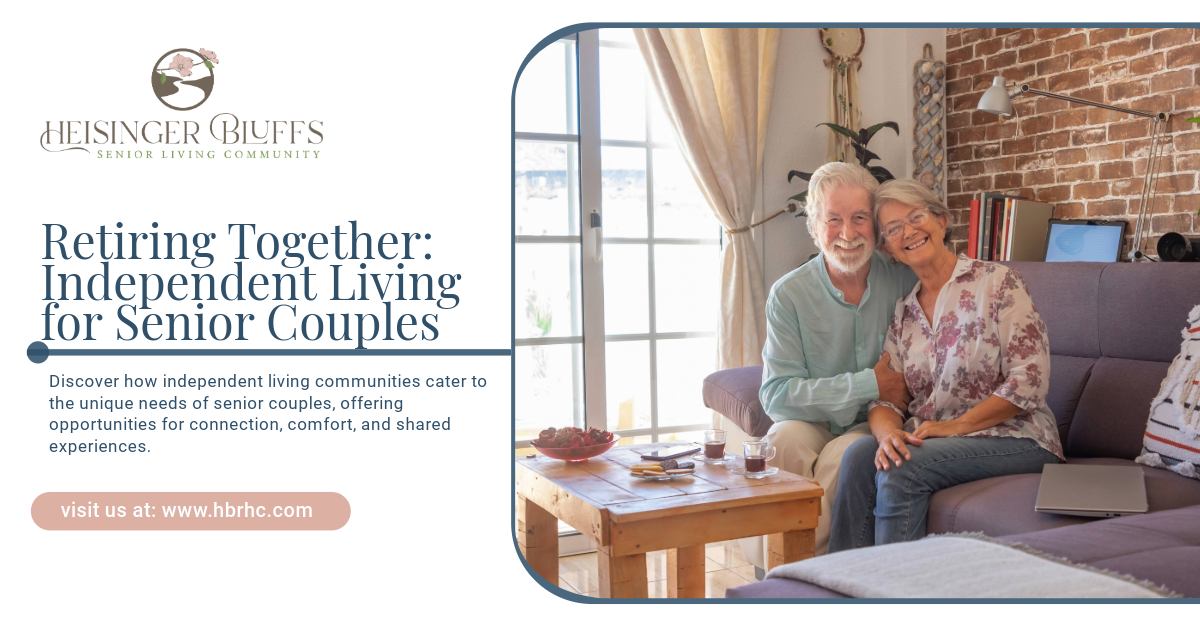Senior Couples’ Guide to Independent Living and Retiring Together

Retirement marks a new chapter, and for senior couples, it’s an opportunity to enjoy life together without the challenges of home maintenance and daily upkeep. Independent living communities provide a perfect solution for couples looking to downsize while maintaining their active and social lifestyle.
This blog explores how independent living communities cater to the unique needs of senior couples, from shared spaces to fostering relationships and independence.
Why Choose Independent Living?
Independent living communities are designed to provide seniors with a lifestyle of ease, convenience, and engagement. These communities prioritize:
- Freedom from Home Maintenance: No more worrying about lawn care, repairs, or housekeeping.
- Enhanced Social Opportunities: Residents can connect with peers through community events and activities.
- Safety and Security: Features like 24/7 staff, secure buildings, and emergency call systems bring peace of mind.
For couples, these benefits allow them to focus on enjoying their time together, exploring hobbies, and making new friends.
Unique Needs of Senior Couples
Senior couples moving into an independent living community often have specific needs and considerations.
1. Shared Living Spaces
Couples typically prefer accommodations that allow them to maintain their shared routines. Spacious apartments or cottages with multiple rooms can provide a sense of home while offering comfort and privacy.
2. Activities for Two
Independent living communities often include activities tailored to couples, such as:
- Fitness classes for partners
- Social events like dances or trivia nights
- Outdoor activities, such as gardening or walking trails
These opportunities allow couples to bond while remaining active and engaged.
3. Health and Wellness Support
While independent living caters to active seniors, many couples appreciate access towellness programs or healthcare options within the community. Preventative care, fitness programs, and on-site health staff can help couples maintain their health together.
Navigating the Transition
Moving into an independent living community is a big step for couples, but planning and open communication can ease the process.
1. Discuss Priorities Together
Before choosing a community, couples should discuss what matters most to them, such as location, amenities, or proximity to family.
2. Tour Communities
Visiting several communities together can help couples find a place that feels like home. Pay attention to apartment layouts, activity schedules, and the friendliness of staff and residents.
3. Simplify Belongings
Downsizing can be an emotional process. Couples can approach it as a team, focusing on keeping items that hold shared sentimental value.
Staying Independent While Staying Together
One of the greatest benefits of independent living is the ability to maintain independence while having support nearby when needed. Couples can continue to live life on their own terms, engaging in the activities they love without the responsibilities of home ownership.
Independent living also allows each partner to pursue individual interests while enjoying shared experiences, ensuring that their needs as individuals and as a couple are met.
The Role of Community
A strong sense of community is vital for senior couples. Independent living communities foster connection through:
- Shared Dining Experiences: Enjoying meals together with peers promotes socialization.
- Group Activities: From book clubs to group outings, there’s always something for couples to join together.
- Supportive Networks: Residents and staff provide companionship and assistance when needed, reducing feelings of isolation.
Planning for the Future
While independent living is ideal for active seniors, many communities also offer access to higher levels of care if needed. For couples, this ensures that both partners can receive support without being separated, even if their needs differ over time.
AtHeisinger Bluffs, we understand the importance of creating a welcoming and enriching environment for senior couples. With thoughtfully designed living spaces, engaging activities, and a strong sense of community, we’re here to help couples thrive in this exciting chapter of their lives. Reach out to learn more about how we can support you and your loved one.
Frequently Asked Questions
What amenities should senior couples look for in an independent living community?
Couples should prioritize amenities that support their lifestyle, such as spacious accommodations, fitness programs, dining options, and social activities tailored to their interests.
Can couples live together in all independent living communities?
Yes, most independent living communities offer units designed for couples, ranging from one-bedroom apartments to larger multi-room options.
What happens if one partner requires additional care?
Many independent living communities provide access to assisted living or healthcare services, ensuring that couples can stay close even if their care needs change.











